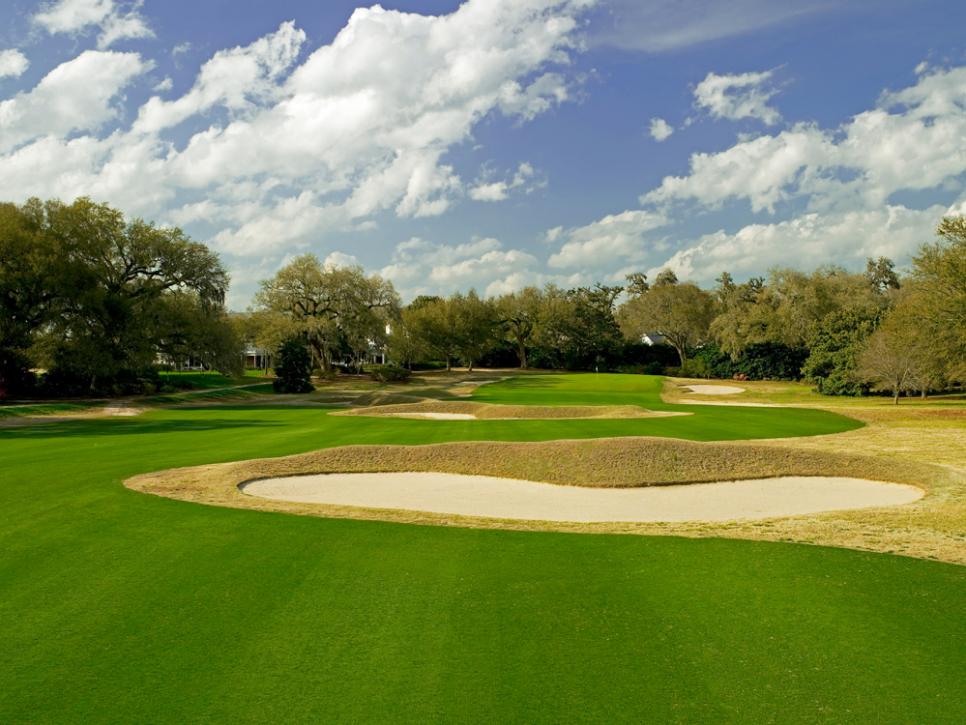Ask an Architect
Are all courses designed by great architects worthy of a faithful restoration?

Yeamans Hall Club, a Seth Raynor design in Charleston, S.C., suffered from neglect for decades, but in the 1980s, the superintendent discovered Raynor’s original plans in the clubhouse attic. Jim Urbina, who consults with the club, has been instrumental in restoring the holes to Raynor's plans since the late 1990s.
LC Lambrecht
Architect Jim Urbina answers our question about which courses are worthy of being restored to their original versions. Urbina began working for Pete Dye in the 1980s and joined with Tom Doak at Renaissance Golf Design in the 1990s to help create America’s 100 Greatest Courses representatives like Pacific Dunes, Old Macdonald and Sebonack. He now consults with Pasatiempo, White Bear Yacht Club, Yeamans Hall among others and will begin a remodel of the Olympic Club’s Ocean Course next year.
Question: We’re in a Golden Age of restoration during which architects and clubs have been returning courses from the 1910s and ’20s back to their original designs. Is this good? Should every historical course be restored as faithfully as possible?
Urbina: Not all designs should be restored faithfully. I’m lucky to have restored three or four Alister MacKenzie courses, but I’m not saying every MacKenzie course should be restored because some have been altered so much by roads, by homes, by easements and such that they may not be worthy of a restoration.
However, take Donald Ross, A.W. Tillinghast and Seth Raynor, for example. Each one of those architects has two, three or four courses that should be preserved forever. I don’t believe every Seth Raynor course should be preserved, though that’s up to the club to determine its value and history as it relates to what kind of course they have today.
When you do a restoration, you often can’t do it perfectly. At Pasatiempo, we can’t put the walking bridge back in on 15. We can’t put the barrancas back to the way they were in 1930 because they’re filled in, and a cart path now goes through there. The modern technologies surrounding what golfers expect today don’t allow us to restore courses perfectly. Courses would go out of business if we returned to greens running six on the Stimpmeter as they did back in those times. However, for the best courses, you can sometimes get to 95-percent back, and if you can, those should be restored.
For the Golden Age, a few of them should all be preserved. Donald Ross’ best works should be preserved. You name the architect, and that person’s best work should be preserved. Who’s going to decide what that best work is? That’s where it gets tricky. That’s subjective.
What about courses from “lesser” architects not named Alister MacKenzie or Donald Ross? Is the work of Robert Bruce Harris or Bill Diddel or George Cobb worthy of restoration?
Yes. If you look at the architects after World War II—Dick Wilson, Robert Trent Jones—and look at all the courses that came online during the golf boom of the 1950s and ’60s, one or two or more of those courses by those architects should be preserved so that others get to see what a real Wilson or Trent Jones had to offer.
Where I live in Colorado, Frank Hummel and Dick Phelps were the guys in the ’70s and ’80s, and I believe that their best work should be preserved. Every state in the union has examples of local architects who defined the golf in those areas, and they deserve to be seen as they were.
Today, that question should be asked to every architect, whether it’s Bill Coore and Ben Crenshaw or Tom Fazio or Jack Nicklaus. I would pose that question. Which of your best one or two courses would you want to preserve? Could you imagine if we would have thought far enough ahead to ask Alister MacKenzie or Perry Maxwell or C.B. Macdonald what courses they would want preserved? We have that chance to ask today’s architects: “Tom Fazio, out of all the dozens or hundreds of courses you’ve built, which ones would you choose to encapsulate? All the others you’ve designed, are they all worthy of preservation or could they be reimagined?” That’s what I would ask them.
MORE:
Ask a super: We all want fast greens, why can’t you just cut them shorter?
Ask a super: I repaired my ball mark, but it still doesn't look right. What did I do wrong?
7 home lawn care tips from golf course superintendents
Aerating greens, explained by a top course superintendent
Why your superintendent is hoping for lots of snow this winter
Ask an architect: Many golfers like fast greens, but do they ruin good architecture?